Device For Control of Difficult to Compress Hemorrhage
a hemorrhage and hemorrhage technology, applied in the field of hemorrhage control devices, can solve the problems of high incidence of penetrating injuries to the extremities and their associated mortality, and achieves the effects of preventing bleeding, low cost and portability, and small footprin
- Summary
- Abstract
- Description
- Claims
- Application Information
AI Technical Summary
Benefits of technology
Problems solved by technology
Method used
Image
Examples
example 1
Reduction and Elimination of Blood Flow in Femoral Artery
[0063]The prototype device of the invention depicted in FIG. 8A was attached to a human subject so that the inflatable bladders rested against the groin, as illustrated schematically in FIG. 7A. One inflatable bladder was inflated to approximately 300 mmHg using hand bulb pump mechanisms; inflation pressure was monitored using an aneroid manometer. The flow of blood through the femoral arteries was monitored using Doppler ultrasoundphotoplethysmography.
[0064]The results of applying pressure on the region of the left femoral artery is depicted in FIGS. 8B and C, where blood flow is shown in the insets and pulsatile blood flow is shown in the lower trace prior to (FIG. 8B) and after (FIG. 8C) the application of pressure by bladder inflation. As can be seen, FIG. 8C shows no blood flow in the inset and the elimination of pulsatile flow in the trace below after inflation of the bladder. These effects were reproducible in both femo...
example 2
In Vivo Demonstration of Hemorrhage Control
[0065]A 40 kg swine was previously instrumented with an abdominal aortic flow probe which measures blood flow going through the abdominal as it exits below the diaphragm. The animal is also instrumented with an arterial catheter in the carotid artery to measure arterial blood pressure and a central venous catheter is placed into the superior vena cava via the external jugular vein to measure central venous pressure (CVP).
[0066]The compression device of the invention was placed around the closed abdomen and snuggly secured. Baseline readings were taken at 13:45. The device was rapidly inflated causing the inflatable members to expand downward towards and in toward the abdominal wall, thereby directing pressure into the abdominal cavity. Hemodynamic measurements were taken from 13:45:30 to 13:47:30 and the results are presented in Table 1. The results demonstrate significant reductions abdominal aortic blood flow with a simultaneous increase ...
example 3
In Vivo Demonstration of Usefulness of the Apparatus as an Adjunct to CPR
[0068]In this example, a 40 kg swine was instrumented as described in Example 2 above. However, the device of the invention was place around the animal's chest. A state of cardiopulmonary arrest was produced by injection of potassium chloride while the animal was anesthetized with alpha choralose. Various parameters were measured as in Example 2, and are presented in Table 2.
TABLE 2Time 13:53:18Time 13:56:00DeflatedInflatedArterial32mmHgArterial45mmHg23mmHg40mmHgCVP8.4mmHgCVP9.5mmHg7.2mmHg8.4mmHgAortic Flow0Aortic Flow0.14ml / min00.17ml / minCPP15.8mmHgCPP31.6mmHgTime 13:54:00Time 13:56:30InflatedDeflatedArterial49mmHgArterial17.6mmHg41mmHg12.8mmHgCVP9.7mmHgCVP6.6mmHg8.5mmHg6.3mmHgAortic Flow0.37ml / minAortic Flow0.01ml / min0.07ml / min0.01ml / minCPP32.5mmHgCPP6.5mmHg
[0069]Time 13:53:18 shows hemodynamic parameters after cardiac arrest with only ventilation with a mechanical ventilator at a tidal volume of 10 cc / kg and...
PUM
 Login to View More
Login to View More Abstract
Description
Claims
Application Information
 Login to View More
Login to View More - R&D
- Intellectual Property
- Life Sciences
- Materials
- Tech Scout
- Unparalleled Data Quality
- Higher Quality Content
- 60% Fewer Hallucinations
Browse by: Latest US Patents, China's latest patents, Technical Efficacy Thesaurus, Application Domain, Technology Topic, Popular Technical Reports.
© 2025 PatSnap. All rights reserved.Legal|Privacy policy|Modern Slavery Act Transparency Statement|Sitemap|About US| Contact US: help@patsnap.com



